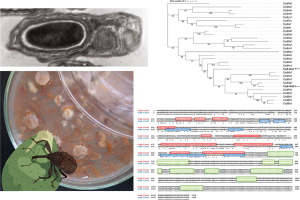Journal of Invertebrate Pathology, 24 February 2021, 107563, 2021
Highlights
• Bacillus thuringiensis FCC 7 isolate is toxic against Anthonomus grandis.
• The strain shows a rounded crystal harboring mainly a protein of about 140 kDa composed by two different types of Cry8 proteins.
• The presence of two cry8-like genes, one vpa and two vpb genes and multiple virulence factors were identified through the whole-genome sequencing analysis.
Abstract
The insecticidal proteins of Bacillus thuringiensis are used in formulations of spore-crystal complexes and their genes have been incorporated into several crops, providing a model for genetic engineering in agriculture. Despite the variability of the Cry proteins described so far, it is still necessary to look for toxins with a broad spectrum of action, since a significant number of pests are not controlled with the available Cry proteins. It is also important to provide alternatives to address the problem of insect resistance, which has already appeared with the use of formulations and with transgenic plants that express cry genes that code for insecticidal proteins. The FCC 7 strain was characterized by the ultrastructural parasporal body under optical and electronic microscopy, and for the detection of Cry8-type proteins by genomic and proteomic approaches. The identity of the strain and the presence of putative toxin encoding genes and virulence factors by Illumina Miseq 1500 platform genomic sequencing was confirmed. The identity of the two Cry8 proteins that make up the parasporal body was confirmed by MALDI-TOF/TOF. To expand knowledge about the insecticidal activity of this strain, we conducted preliminary tests against the cotton boll weevil, Anthonomus grandis. Here we report the characterization of a novel B. thuringiensis isolate native to Argentina (FCC 7) toxic against A. grandis. The strain shows a rounded parasporal body harboring mainly a protein of about 140 kDa and two different types of Cry8 proteins. Through whole-genome sequencing, we identified the presence of two cry8-like crystal protein genes, one vpa-like and two vpb-like genes, and multiple virulence factors, deepening the knowledge of a strain that had already been described as toxic against some lepidopterans and coleopterans, including Spodoptera frugiperda, Anticarsia gemmatalis, Tenebrio molitor and Diabrotica speciosa.
Keywords
biological control, Coleoptera, Lepidoptera, MALDI-TOF/TOF,Whole-genome, cry8-type genes
Graphical abstract
